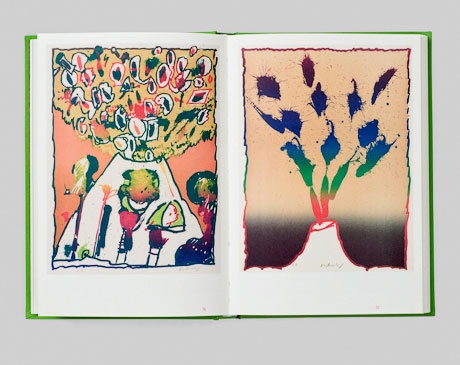Peter Bramsen and Pierre Alechinsky — 40 years of artistic friendship

Alechinsky’s reptilian imagination is not terrifying. It rather raises sympathy of a kind we have sometimes towards creatures from children tales about Bromba and Filidor or the Moomins. These snakes, apparitions and spiders can only play harmless pranks or get into not serious trouble. This contemporary Belgian artist resembles his older compatriot James Ensor, whose skulls and skeletons had been also very friendly.
Agnieszka Sabor
‘Four Hand Bestiary’, ‘Tygodnik Powszechny’, No. 42(2780), October 20th, 2002
Curator of the exhibition: Christian Bramsen
The exhibition is co-organised with Ars Cameralis Silesiae Superioris and the Academy of Fine Arts in Katowice.

‘Peter i Pierre. Peter Bramsen i Pierre Alechinsky — 40 years of artistic friendship’ “(…) Pierre, Peter, a rock — it had all been going around in my head for a long time, until I went for a trip once and...

The exhibition Peter & Pierre includes 160 lithographs by Alechinsky. All of them were made at the Atelier Clot, Bramsen & Georges in Paris. The collaboration between Alechinsky and Bramsen had begun in the middle of the sixties and brought excellent results.
Pierre Alechinsky was born in 1927 in Brussels. In 1949 he joined the international interdisciplinary group CoBrA (an acronym of the names of the member cities: Copenhagen, Brussels, and Amsterdam), which appeared just after the breakdown of the group Surréalisme Révolutionaire, and soon became its most important artist. The program of the Cobra group, which was formulated by Christian Dotremont, called for ‘organic experimental collaboration, and avoidance of all idle and dogmatic theories’. In practice this translated into group work ‘for four hands’ and the interest in popular art, children painting and the mentally sick painting. As far as style is concerned, Cobra art was oscillating around abstractive tendencies and expressionist figuration with stress put on revealing the ‘imagination of the unconsciousness, without getting past censors of the reflecting mind’. Cobra’s sting was directed against bourgeois pedantry and all esotericism.
Brussels milieu, to which Alechinsky belonged at that time, had included mainly writers. The alliance between the letter and the picture is another characteristic feature of his art. In his childhood he was considered retarded because of his left-handedness. In his adult life he turned it into an advantage and force of his art. The letter was complementing the sense of his works. After the breakdown of the Cobra group in 1951 Alechinsky moved to Paris, still being faithful to its non-doctrinaire principles. He proved himself to be an experimentalist in the field of various techniques and styles. In 1955 he left for Japan as one of firsts to study Japanese painting and shoot a film about Japanese school of calligraphy. Using collective imagination, as well as Jungean archetypes and myths still remains the characteristic feature of Alechinsky. In his printmaking experiments of the 60s he was joining various techniques, and enriching his works in decorative bordures. The latter were a kind of notes in the margin of the main scenes and aimed at widening his compositions.
Alechinsky’s lithographs are obvious classical works of the genre; at the same time they prove about Alechinsky’ experiments and threads of unusually fascinating time. Today artistic trends are determined by other artists within the Belgian circle of artists; in spite of this, however, the creation of Pierre Alechinsky returns from time to time as a model.
Stanisław Ruksza
fragment of the text ‘Printmaking without idle theories’, ‘Ultramaryna’ No.11(62) 2006

